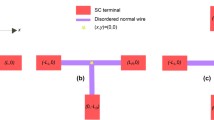Abstract
We study exact self-duality in the model of a Brownian particle in a washboard (WB) potential which describes a Josephson junction (JJ) coupled to an environment, for arbitrary temperature and arbitrary form of the spectral density of the environment. To this end we introduce the quantum dissipative Villain model (QDVM), which models tunneling of a degree of freedom coupled to a linear quantum environment through an infinite set of states. We derive general exact mappings on various dual discrete representations (one-dimensional Coulomb gases or surface-roughening models) which are exactly self-dual. Then we show how the QDVM maps exactly onto the WB model and use duality relations to calculate the leading terms of the total impedance of a JJ circuit, for general frequency dependence of the spectral density of the environment and arbitrary temperature.
Similar content being viewed by others
REFERENCES
U. Weiss, Quantum Dissipative Systems, Series in Modern Condensed Matter Physics, vol. 2, 2d ed. (World Scientific, Singapore, 1998).
A. J. Leggett, in Directions in Condensed Matter Physics, vol. 1., G. Grinstein and G. Mazenko, eds. (World Scientific, Singapore, 1986), p. 187.
A. O. Caldeira and A. J. Leggett, Phys. Rev. Lett. 46, 211 (1981).
G. Schön and A. D. Zaikin, Phys. Rep. 198, 237 (1990); D. A. Averin and K. K. Likharev, in Quantum Effects in Small Disordered Systems, B. L. Altshuler, P. A. Lee, and R. A. Webb, eds. (Elsevier, Amsterdam, 1991).
G. L. Ingold and Yu. V. Nazarov, in Single Charge Tunneling, H. Grabert and M. Devoret, eds. (Plenum Press, New York, 1991).
A. J. Leggett, Phys. Rev. B, 30, 1208 (1984).
G. Falci, V. Bubanja, and G. Schön, Europhys. Lett. 16, 109 (1991); Z. Phys. B 85, 451 (1991).
A. Schmid, Phys. Rev. Lett. 51, 1506 (1983).
M. P. A. Fisher and W. Zwerger, Phys. Rev. B 32, 6190 (1985); W. Zwerger, Phys. Rev. B 35, 4737 (1987).
M. Sassetti, H. Schomerus, and U. Weiss, Phys. Rev. B 53, R2914 (1996).
P. Fendley and H. Saleur, cond-mat/9804173, 16 April 1998.
P. Fendley, A. W. W. Ludwig, and H. Saleur, Phys. Rev. Lett. 75, 8934 (1995); F. Lesage, H. Saleur, and S. Shorik, Phys. Rev. Lett. 76, 3384 (1996); U. Weiss, Solid State Commun. 100, 281 (1996); U. Weiss, in Tunneling and Its Implications, L. S. Schulman, A. Ranfagni, and D. Mugnai, eds. (World Scientific, Singapore, 1997).
S. T. Chui and J. D. Weeks, Phys. Rev. B 14, 4978 (1983).
J. Villain, J. Phys. (Paris) 36, 581 (1976).
S. Korshunov, Europhys. Lett. 9, 107 (1989); W. Zwerger, Z. Phys. B 78, 111 (1990); R. Fazio and G. Schön, Phys. Rev. B 43, 5307 (1991).
G. Falci and U. Weiss, in Path-Integral from peV to TeV, R. Casalbuoni et al., eds. (World Scientific, Singapore, 1999), p. 379.
M. H. Devoret, D. Esteve, H. Grabert, G. L. Ingold, H. Pothier, and C. Urbina, Phys. Rev. Lett. 64, 1824 (1990); S. M. Girvin, L. Glazman, M. Jonson, D. R. Penn, and M. D. Stiles, Phys. Rev. Lett. 54, 3183 (1990); D. A. Averin, Yu. V. Nazarov and A. A. Odintsov, Physica B 165, 166, 945 (1990); Yu. V. Nazarov, J. Siewert, and G. Falci, Europhys. Lett. 38, 365 (1997); R. Cristiano, L. Frunzio, G. Falci, and A. Tagliacozzo, in Tunneling and Its Implications, L. S. Schulman, A. Ranfagni, and D. Mugnai, eds. (World Scientific, Singapore, 1997), p. 161.
Author information
Authors and Affiliations
Rights and permissions
About this article
Cite this article
Falci, G., Weiss, U. Duality in the Quantum Dissipative Villain Model and Application to Mesoscopic Josephson Junction Circuits. Journal of Superconductivity 12, 783–787 (1999). https://doi.org/10.1023/A:1007789127384
Issue Date:
DOI: https://doi.org/10.1023/A:1007789127384




